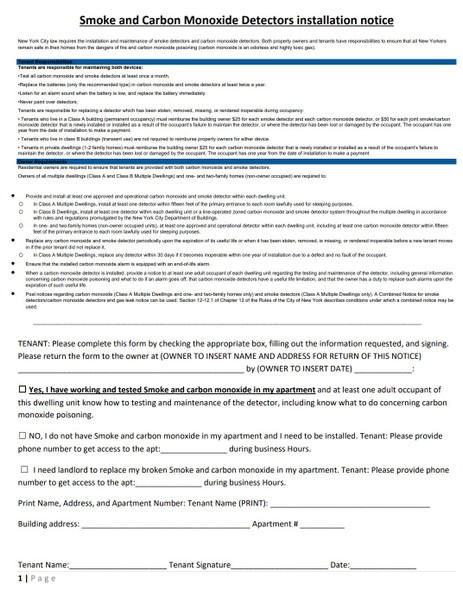hpdsigns.nyc
Where to Install Natural Gas Detectors in an Apartment (pdf file)
- SKU:
- Where to Install Natural Gas Detectors in an Apartment
- UPC:
- MPN:
- Where to Install Natural Gas Detectors i
Description
Where to Install Natural Gas Detectors in an Apartment
To comply with New York State regulations and ensure maximum safety, consider the following guidelines for installing natural gas detectors in an apartment:
Near Gas Appliances
-
Kitchens: Install natural gas detectors near gas stoves and ovens. Position the detector within 10-15 feet of the appliance but avoid placing it directly above the stove to prevent false alarms from normal cooking fumes.
-
Laundry Rooms: If your apartment has a gas-powered clothes dryer, place a detector nearby. Ensure it is within 10-15 feet of the dryer but not obstructed by laundry or other items.
-
Heating Systems: For apartments with gas-powered heating systems or water heaters, install detectors in the same room. Place the detector within the vicinity of these appliances, ensuring it is close enough to detect leaks but not directly above the appliance to avoid false alarms from heat emissions.
Living Spaces and Bedrooms
-
Living Rooms: Place a natural gas detector in the living room, especially if it contains a fireplace or any gas-powered space heaters. Position the detector at a height where it can effectively sense gas accumulation, typically within 10 feet of potential gas sources.
-
Bedrooms: Install detectors outside sleeping areas to ensure that leaks are detected while occupants are asleep. Position the detector in the hallway or common area leading to the bedrooms, at a height where gas is likely to accumulate.
Utility and Storage Areas
- Basements and Utility Rooms: If your apartment has a basement or a utility room where gas lines enter the building or where gas meters are located, place a detector in these areas. Gas tends to settle in lower areas, so positioning detectors in basements can provide early warning of leaks.
General Installation Tips
-
Height and Placement: Natural gas is lighter than air and tends to rise. Therefore, place detectors high on the wall, about a foot below the ceiling, or directly on the ceiling for optimal detection.
-
Avoid Obstructions: Ensure that the detectors are not blocked by furniture, curtains, or other objects that could impede the detection of gas leaks.
-
Multiple Levels: If your apartment has multiple levels, install detectors on each level to ensure comprehensive coverage.
-
Regular Maintenance: Test detectors regularly to ensure they are functioning properly. Replace batteries as needed and follow the manufacturer's instructions for maintenance.
Conclusion
The proper installation of natural gas detectors in apartments is a critical step in ensuring the safety and well-being of occupants. By following New York State law and placing detectors in strategic locations such as near gas appliances, in living spaces, bedrooms, and utility areas, residents can be assured of early detection and timely response to gas leaks. Regular maintenance and testing of these detectors further enhance their reliability and effectiveness. Prioritizing the installation of natural gas detectors is a vital aspect of creating a safe living environment in any apartment.
DISCLAIMER to comply with the New York City Consumer Protection Law which applies to all businesses operating in New York City: We are small family-owned and family-operated Brooklyn-based business. We are not a City of New York store nor are the website, products or services affiliated with the City of New York or any agency of the City of New York. We ourselves, our business, websites, products, services, or any hyperlinks from its website are not sponsored by, approved by, affiliated with, endorsed by, or connected to the City of New York or any agency of the City of New York, including but not limited to HPD, DOB, DOT, DSNY, FDNY and federal directly or by implication.
DISCLAIMER These codes may not be the most recent version. The State / federal or other regulation department may have more current or accurate information. We make no warranties or guarantees about the accuracy, completeness, or adequacy of the information contained on this site or the information linked to on the state site. Please check official sources.
The requirements for PRODUCT are determined by intended use and by applicable regulation. The BUYER is responsible for determining the appropriate content for and suitability. WE make no warranty or representation of suitability for any specific application. IT IS THE CUSTOMER'S RESPONSIBILITY TO ENSURE THAT THE PRODUCT THE CUSTOMER ORDERS ARE IN COMPLIANCE WITH ALL STATE, FEDERAL, LOCAL, AND MUNICIPAL LAWS. Please review terms and conditions prior to purchase.
For more information about what is required, see the laws that are referenced and the rules applicable to your city and state. This page is for informational purposes only and is not intended as legal advice, professional advice or a statement of law. You may wish to consult with an attorney.
Related Products

Checklist for Installing Natural Gas Detectors requirments per LL157 (pdf file)
hpdsigns.nyc


Natural Gas Detectors LL157 (PDF)
hpdsigns.nyc


Smoke and Carbon monoxide detector installation notice (pdf file)
hpdsigns.nyc

Natural Gas Safety and the Importance of Leak Detectors: Guidance from FDNY (pdf file)
hpdsigns.nyc


What type of Natural Gas Detectors shell i install per LL157 (word Doc file)
hpdsigns.nyc

Carbon Monoxide Detector Installation Notice -HMC § 27-2046.1 (pdf file)
hpdsigns.nyc







